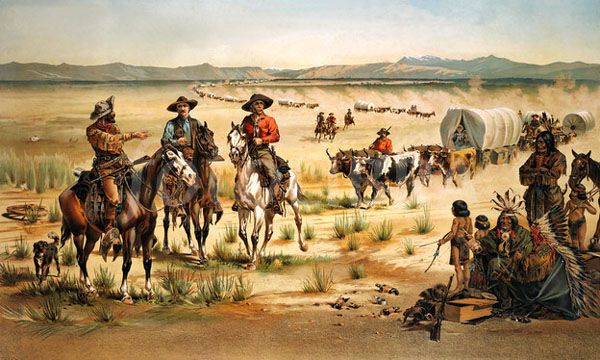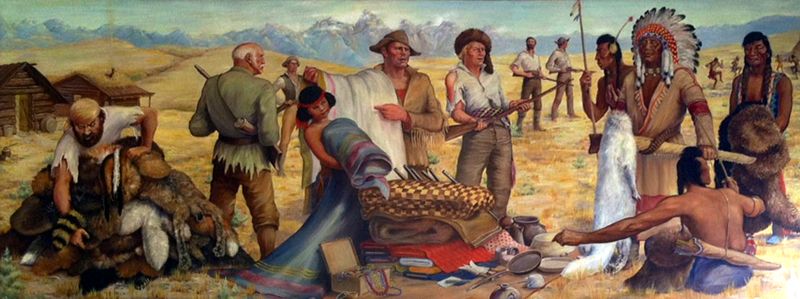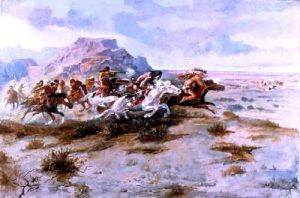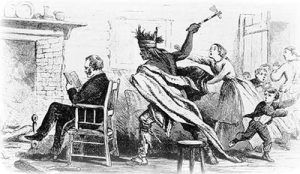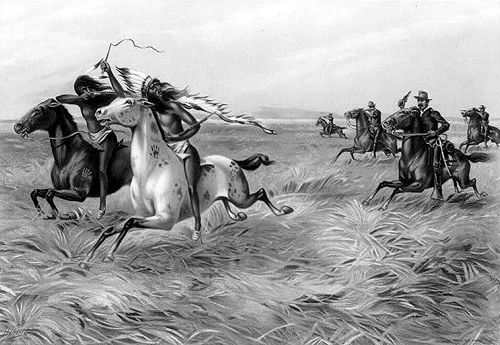Indians and Emigrants on the Overland Trails – Legends of America (original) (raw)
A wagon train and Indians
Contrary to Hollywood depictions and popular myths that portray the natives in a negative light as savages, mercilessly victimizing pioneers, the historical record presents a different story. In fact, sustained attacks by Indians on wagon trains were rare, and encounters between Indians and emigrants were, more often, peaceful and mutually advantageous.
One of the common scenes in western films shows circled wagon trains under attack by Indians. However, pioneers circled their wagons at night mostly to keep their draft animals from wandering off, not to protect against an ambush.
A study by historian John Unruh concluded that just over 360 emigrants were killed due to Indian attacks along the trail between 1840 and 1860 – most of them during the 1850s. In comparison, he estimates that emigrants killed more than 425 Indians during the same period.
Instead of violent conflict, most Indians were helpful and generally friendly – providing needed supplies for the pioneers, operating ferries across the many rivers along the trail, helping to manage livestock, and acting as guides.
Trading with the Indians
Early on, the Indians were most interested in peaceful trading, trading clothes, tobacco, firearms, food, and small items such as mirrors, tin cups, fish hooks, or metal tools.
A few times a year, the Sioux and Cheyenne would head to Fort Laramie, Wyoming, to trade buffalo skins and furs for things like blankets, tobacco, lead, and powder.
The more pressing threats to the pioneers were cholera and other diseases, responsible for most of the estimated 20,000 deaths along the Oregon Trail.
Indian Attack by Charles Marion Russell
Of the early conflicts, most violence and fatalities came from small skirmishes due to paranoia, retaliation, or livestock theft by the Indians. However, few, if any, of the pioneers fell to Indian arrows. The pioneers were much better armed, and few trains were out of sight of one another. As accomplished military strategists, the natives realized they would be disadvantaged in a war-like encounter.
In fact, many incidents were the work of criminals called “white Indians,” notorious for their brutality. One 1850 traveler concluded that “the savage Indians_” were “_afraid to come near the road_” and “_near all the stealing and killing is done by the Whites following the Trains.”
Violent attacks on small, isolated trains or individuals rose after the 1850s as native hostility grew toward white settlers. As more and more pioneers passed through their lands, disrespecting their sacred grounds and customs, reducing the number of buffalo, and passing along new diseases, the natives became angrier and angrier.
In 1851, the Sioux signed the Fort Laramie Treaty of 1851, in which they agreed to allow settlers from the east to travel through their land for a yearly payment of $50,000. Unfortunately, the treaty was short-lived, as officials refused to honor it.
Whitman Massacre
There were several sensational incidents, such as the Whitman Massacre in present-day Washington in 1847, the Bloody Point Massacre at Tule Lake, California, in 1852, the 1854 attack on the Ward wagon train near Fort Boise, Idaho, and the 1860 Utter-Van Orman attack near Salmon Falls, Idaho on the Snake River. These accounts received wide publicity and caused the nervous and suspicious pioneers to retaliate with the indiscriminate killing of unsuspecting Indians.
Alternatively, countless exchanges of kindness and hospitality were noted in emigrant journals, but these did not grab newspaper headlines and stoke public outrage.
“_We are continually hearing of the depredations of the Indians, but we have not seen one yet._” Caroline Richardson, 1852.
Hostile encounters with the Indians increased in the years after the Civil War began. The great majority of these violent conflicts occurred west of the Rocky Mountains, which was by far the most dangerous portion of the overland journey.
U.S. Calvary chasing Indians
With each passing year, relations between the pioneers and the Indians deteriorated.
In the summer of 1867, hostilities between the two groups were so bad that the U.S. Army forbade travel by single wagons in western Kansas.
In the end, numerous Indian Wars would be fought before the U.S. Government could “tame” the Indians and place them on reservations.
©Kathy Alexander/Legends of America, updated March 2023.
Also See:
Danger and Hardship on the Oregon Trail
Diminishing the Indians in California
Indian Wars, Battles & Massacres
Indian Wars of the Frontier West by Emerson Hough
Sources:
Bureau of Land Management
List Verse
Oregon-California Trail Association
Oregon History Project
